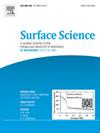First-principles prediction of a novel 2D InAs/PtSe2 direct Z-scheme van der Waals heterojunction for overall water-splitting
IF 1.8
4区 化学
Q3 CHEMISTRY, PHYSICAL
引用次数: 0
Abstract
The construction of heterojunctions presents a promising strategy for developing efficient photocatalysts for hydrogen production via water decomposition. In this paper, a new type of two-dimensional (2D) InAs/PtSe2 direct Z-scheme van der Walls (vdWs) heterojunction is designed. Utilizing the first-principles density functional theory (DFT), we systematically investigate its geometric structure, electronic, optical and photocatalytic characteristics. Our findings indicate that the heterojunction exhibits a type-II band alignment, coupled with an intrinsic electric field oriented from InAs to PtSe2 at the interface. The synergistic effect of the electric field and energy band bending effectively promotes separation of photogenerated carriers. Moreover, the InAs/PtSe2 heterojunction demonstrates superior photocatalytic water-splitting performance, enabling spontaneous hydrogen evolution in both acidic and neutral environments. These results position the 2D InAs/PtSe2 direct Z-scheme vdWs heterojunction as a highly promising material for efficient solar-driven water-splitting applications.

新型二维InAs/PtSe2直接z -图式范德华异质结的第一性原理预测
异质结的构建为开发高效的水分解制氢光催化剂提供了一种很有前途的策略。本文设计了一种新型的二维(2D) InAs/PtSe2直接Z-scheme van der Walls (vdWs)异质结。利用第一性原理密度泛函理论(DFT),系统地研究了其几何结构、电子、光学和光催化特性。我们的研究结果表明,异质结表现出ii型带对准,并且在界面处具有从InAs到PtSe2取向的本征电场。电场和能带弯曲的协同作用有效地促进了光生载流子的分离。此外,InAs/PtSe2异质结表现出优异的光催化水分解性能,在酸性和中性环境下都能自发析氢。这些结果将2D InAs/PtSe2直接Z-scheme vdWs异质结定位为一种非常有前途的材料,用于高效的太阳能驱动水分解应用。
本文章由计算机程序翻译,如有差异,请以英文原文为准。
求助全文
约1分钟内获得全文
求助全文
来源期刊

Surface Science
化学-物理:凝聚态物理
CiteScore
3.30
自引率
5.30%
发文量
137
审稿时长
25 days
期刊介绍:
Surface Science is devoted to elucidating the fundamental aspects of chemistry and physics occurring at a wide range of surfaces and interfaces and to disseminating this knowledge fast. The journal welcomes a broad spectrum of topics, including but not limited to:
• model systems (e.g. in Ultra High Vacuum) under well-controlled reactive conditions
• nanoscale science and engineering, including manipulation of matter at the atomic/molecular scale and assembly phenomena
• reactivity of surfaces as related to various applied areas including heterogeneous catalysis, chemistry at electrified interfaces, and semiconductors functionalization
• phenomena at interfaces relevant to energy storage and conversion, and fuels production and utilization
• surface reactivity for environmental protection and pollution remediation
• interactions at surfaces of soft matter, including polymers and biomaterials.
Both experimental and theoretical work, including modeling, is within the scope of the journal. Work published in Surface Science reaches a wide readership, from chemistry and physics to biology and materials science and engineering, providing an excellent forum for cross-fertilization of ideas and broad dissemination of scientific discoveries.
 求助内容:
求助内容: 应助结果提醒方式:
应助结果提醒方式:


